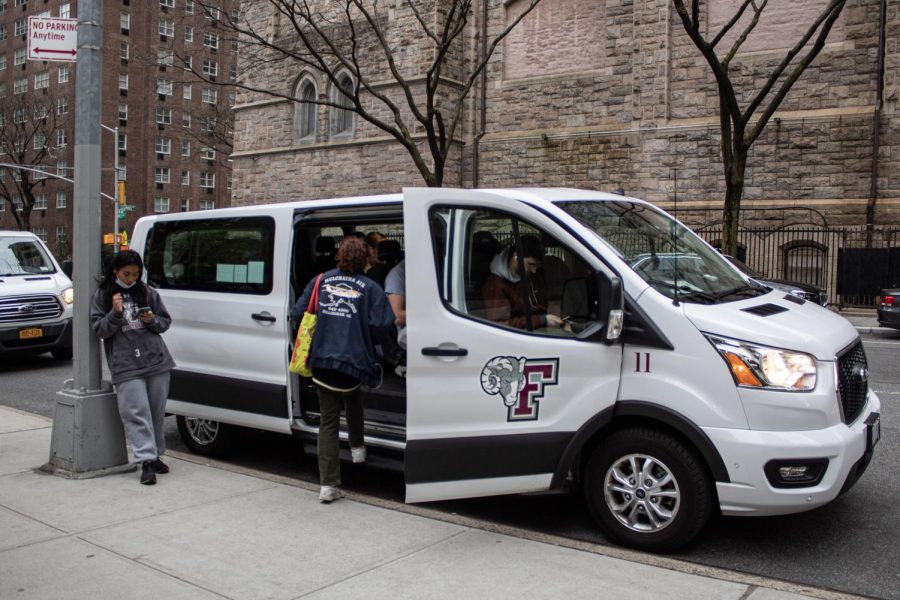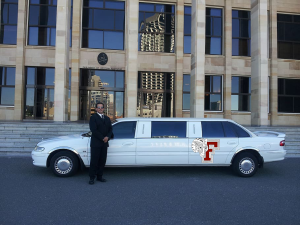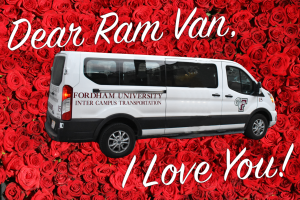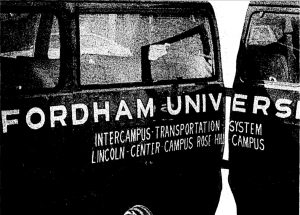The Ram Van: A Driving Force for Intercampus Connections
Fordham’s intercampus transport is an essential aspect of the institution
May 15, 2022
Whether you’re a student enrolled in a class or a professor teaching a class at the other campus, you have probably taken the Ram Van. The university’s intercampus shuttle service has acted as a link between Fordham’s Rose Hill and Lincoln Center campuses for over 30 years. The shuttle service also makes scheduled trips to Fordham’s Calder Center in Armonk, New York.
Across both campuses, the shuttle service has brought staff, faculty and students together, allowing for new relationships to foster and current ones to grow.
The Ram Van began its operation in 1979 as a means of transporting individuals between the university’s campuses. Originally, there was only one van in service and seats were limited to about five passengers. Additional vans were added as demand increased over the years, and each van can now seat up to 14 passengers. Over time, the Ram Van began making stops from Rose Hill to the D train, as well as to other locations along the routes between the campuses.
In 1997, students were able to register for a spot on the Ram Van by signing up at the security desk in the Leon Lowenstein Building at Lincoln Center or at the Ram Van office across from the O’Hare Hall at Rose Hill. This system eventually went online in 2013. The intercampus shuttle service today has a staff of over 120 student workers who drive approximately 570 round trips between Rose Hill and Lincoln Center every week, transporting upward of 7,000 passengers, according to Plinio Gonzalez, Gabelli School of Business at Rose Hill ’08 and director of university transportation.
In 2020, during the COVID-19 pandemic, Ram Van service resumed at 50% vehicle occupancy and implemented cleaning protocols in compliance with COVID-19 preventative measures. Currently, the Ram Van service is back to 100% vehicle occupancy with the mandate for all passengers to wear face coverings.
For many students, the Ram Van is an essential part of their daily routine in order to commute to their classes at another campus. Although a trip in a Ram Van normally costs $3.50, students who take classes at a different campus or participate in clubs, which do not have an equivalent offered at their home campus, receive free passes for their rides.
In addition to providing transportation to classes, the Ram Van has also allowed students the opportunity to become involved with activities and extracurriculars not offered at their home campus.
“(The Ram Van) provides an opportunity to take classes on both campuses, which really enriches our experience and our ability to find different opportunities for classes,” Emma Dileas, Fordham College at Lincoln Center (FCLC) ’23 and a Ram Van driver, said.
In addition to providing transportation to classes, the Ram Van has also allowed students the opportunity to become involved with activities and extracurriculars not offered at their home campus. Isaac Davis, FCLC ’24, is involved in a number of activities and extracurriculars at the Rose Hill campus.
“A lot of my work is done at Rose Hill for open mics at Rod’s, television shoots and medieval studies meetings,” he said.
While the drivers are the faces that most Fordham students associate with the Ram Van, there is an entire system working behind the scenes to keep the vans moving. These include dispatchers, fuelers and a team of administrators.
Pavel Vasilyev, FCLC ’25 and a Ram Van driver, said the “fulfillment from serving the student body” is what distinguishes Ram Van from other work-study jobs at Fordham. Dileas echoed this sentiment.
“It really is a strong community. We’re very committed to each other as co-workers,” Dileas said. “Out of other jobs I’ve had, this is the closest group of co-workers I’ve had.”
Although the Ram Van remains a part of the Fordham experience, it has faced some challenges and criticism over the years. Some students have complained about the cramped conditions and motion sickness.
This sense of community and distinct working experience is what led former Ram Van driver Gonzalez to return to Fordham in 2017. In his role as director of university transportation, Gonzalez is responsible for leading the Ram Van system and improving the vans in order to ensure the safety of all passengers.
“(I) yearned to be a part of a company with the same type of culture that is found in the Ram Van office, which is a fast-paced, fulfilling work environment,” Gonzalez said about why he returned to Ram Van after graduating.
Although the Ram Van remains a part of the Fordham experience, it has faced some challenges and criticism over the years. Some students have complained about the cramped conditions and motion sickness.
“There’s no suspension in those things,” Felix Zhao, FCLC ’24, said. “If there’s a bump, you feel that in your spine.”
Zhao found that the lack of proper ventilation makes it difficult to breathe, saying that it is “nauseating, cramped and never at a comfortable temperature.”
Davis is vocal about the stigma against the Ram Van, stating that the shuttle service is an enjoyable experience.
“I like the sense of relaxation I get from having about 30 minutes without a care in the world, just listening to my playlist and watching the New York skyline,” Davis said.
Gonzalez said that he encourages Fordham students to work for Ram Van in order to directly help the university community in a tangible way.
“Without the Ram Van, the opportunities to take advantage of the slogan ‘New York is my campus. Fordham is my school,’ would certainly be lessened,” he added.














